The Dianas (Part One)
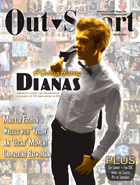 At 57 years of age, the nation’s oldest continually active gay organization is Houston’s own Diana Foundation.
At 57 years of age, the nation’s oldest continually active gay organization is Houston’s own Diana Foundation.
by Brandon Wolf
When Houston florist David Moncrief threw an evening cocktail party in the spring of 1954, he was unaware he was in the process of making gay history. The small gathering in his living room was simply for the purpose of watching the Academy Awards on television with a group of gay friends.
A man with a spirited sense of humor, Moncrief bought a gag award for one of his friends. His casual joke struck a chord that led to the founding of Houston’s Diana Foundation. Today, the Dianas are the oldest continually active gay organization in the United States.
It’s a special cachet for Houston’s gay community that an organization of national significance emerged from our midst, but the Diana Foundation’s 57-year history is a story that, until now, has not been told. To write this story, nearly 100 people were consulted: 55 Diana members, past and present; 30 people with knowledge of Houston’s history and/or Houston’s gay history; and 10 people familiar with national gay history. We reviewed some 4,000 photographs, 12 videotaped Diana Awards shows, 35 souvenir programs, and nearly 500 pages of documents currently housed at the Charles Botts Collection archive.
From this research comes a view of the Dianas that chronicles their 57-year evolution, their origin, the challenges they have overcome, and a perspective on their iconic importance. Now OutSmart presents for the first time an overview of their story in a two-part series.
Show biz is a gay tradition. No doubt we were there when Thespis wrote and staged his first dramas in Greece 500 years BJ. Fast forward 2,500 years, and we’re among Hollywood’s greatest artists and fans. Directorial legend D. W. Griffith is said to have discovered the pleasant little village of Hollywood in 1906, where he made his first feature-length film in 1913. Just 16 years later, in 1929, the elder Douglas Fairbanks hosted the budding film industry’s very first Academy Awards ceremony at the Hotel Roosevelt in Hollywood.
Suspense was absent that evening because the winners had been announced three months in advance, and the event was simply a formal recognition of their honors. Named as “the best” were: the movie Wings, actor Emil Jannings, and actress Janet Gaynor.
In the Awards second year, a Los Angeles radio station began annual broadcasts of the event for local listeners, with the rest of the nation receiving the news through newspaper reports. Results were given to the print media in advance, with a release embargo of 11 p.m. the evening of the awards.
By 1944, interest in the awards ran so high that national network radio broadcast the ceremony live, as listeners throughout the country gathered around their radios. And then there was television…
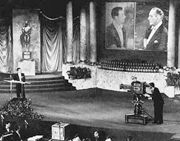
The 1950s
The Dianas-to-Be Watch as the Academy Awards Come to Television
On Thursday, March 19, 1953, the country was buzzing—the Academy Awards, then 24 years old, were to be broadcast on television that evening. For the first time, Americans would be able to see the faces of the winners as their names were announced and watch them rush to the podium to accept their awards.
In Houston, David Moncrief, a gay man who loved to entertain, was so excited about the upcoming broadcast he purchased a new television set and invited a group of about ten friends to join him at his apartment for a pre-awards cocktail party and to watch the first televised Oscar broadcast.
Curtis Wright, the head of Sakowitz’s window-trimming department, was Moncrief’s roommate at the time and was responsible for the placement of a nearly life-size plaster model of Diana, the Roman goddess of the hunt, which stood in one corner of their living room. One of the guests that night, Johnna Lee Mueller, then in her early 20s and a model at Sakowitz Department Store, remembers it standing in Moncrief’s beautiful New Orleans French Quarter-styled home. The statue reminded Mueller of the Diana statue on the grounds of Ima Hogg’s Bayou Bend mansion in River Oaks. Diana’s toga stopped just above the knees, and her right hand was reaching over a shoulder towards a quiver on her back.
Mueller doesn’t recall who the other guests were that evening, but thinks it likely that among them were the other gay people she socialized with regularly—Jimmy Valentine, Clinton Quinn, Edward Terry, Wray Query, Charles Temple, Tom Adams, Bob Wilson, Charles Knight, Alan Richard, Glenn Smith, Virginia Lankford, Jack Horton. The women wore cocktail dresses, and the men were natty in their stylish suits and ties.
The guests ate hors d’oeuvres and enjoyed cocktail chatter until the time of the awaited Oscar broadcast, she recalls. But when the anticipated moment arrived, Moncrief turned on the television set and reception failed! While other Americans watched Shirley Booth’s face break into delight at being named Best Actress for her role in Come Back Little Sheba, the group at Moncrief’s party listened to a radio announcer describe the event.
“We just laughed it off,” remembers Mueller. The party had not proceeded as Moncrief had planned, but it served as an important catalyst for the birth of Houston’s Dianas one year later.
The First Diana Award
Undaunted by the 1953 failure, Moncrief again invited a group of friends to his apartment at 3416 Louisiana to watch the 1954 television broadcast. It was on Thursday, March 25, and many of the same guests were invited. New to the party that year were local mortgage banker Charles Hebert and his partner Jack Bresnahan. The two had met while serving in the armed forces together at Ellington Air Force Base, and Bresnahan was still in the service at the time.
Bresnahan recalls seeing the statue that Mueller noted the year before. Moncrief had festively decorated the plaster goddess with leis around her neck. It was a funny, campy sight, Bresnahan says. Diana appeared to be partying right along with the rest of the group.
Just prior to the broadcast, Moncrief asked for everyone’s attention and announced that he had an award for someone in Houston who had given an outstanding “performance”—most likely an amorous adventure—during the past year. As the guests laughed and applauded, Moncrief presented the very first Diana Award—a dildo—to Virginia “Hub” Lankford, who accepted it with mock surprise and amusement.
The guests’ attention turned to the Oscar broadcast for the remainder of the evening. The big winners that year were all black-and-white films. Frank Zinnemann’s From Here to Eternity took eight Oscars, including Best Picture. Frank Sinatra and Donna Reed took top honors for their supporting roles in Zinnemann’s big hit, while William Holden won Best Actor for his performance in Stalag 17, and Audrey Hepburn snagged Best Actress for her role as an errant European princess in Roman Holiday.
Moncrief‘s mock award, a roast really, was a rollicking element of the 1954 party. The roast idea was amusing enough to be repeated annually for the next 55 years.
Even Moncrief’s choice of the evening’s award was ironically appropriate. The annual Diana Awards would always be heavily tinged with overt sexual overtones and bawdy humor. They would appeal to people with quick wits, unrepressed sexuality, a lack of social conformity, and the ability to laugh at themselves.
A Good Idea Grows
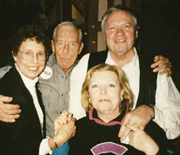
No one remembers exactly what direction the Diana Awards took after 1954, but 1954 is commonly accepted as Diana 1. Bresnahan was still in the service in 1955 and unable to attend Diana 2. Hebert and Tom Adams, also a guest at Diana 1, shared the same quick wit, and it’s possible that they took a cue from Moncrief’s campy award in 1954 and decided to expand upon the idea.
Diana 2 in 1955 was probably held at David Moncrief’s apartment on Louisiana. Hebert’s apartment at 1934 North Boulevard would have been too small to host the event, and Adams was dealing with family matters and living away from Houston at the time.
Tradition says that the awards were named the “Diana Awards” in honor of the Diana statue that graced Moncrief’s living room and presided over the first award presentation. Because the awards were meant to mimic the Oscars, a campy name was needed and “Dianas” seemed a good choice. It’s not certain whether the Diana name began with Diana 1, 2, or 3.
Bresnahan left the service in late 1955 and was living with Hebert when the Motion Picture Academy announced the Oscar nominees six weeks prior to the Academy Awards ceremony. He has a clear memory of Moncrief, Hebert and Adams working behind closed doors, earnestly writing the Diana 3 awards. The Diana name already had symbolic significance as the trio set out to “hunt down” a new round of victims for their verbal “arrows.”
In 1956, Adams moved to 2120 Kipling, near the Alabama Theater. Mueller recalls that he rented a party room one year for the awards. There’s some evidence that Diana 3 in 1956 was held in The Groove Record Shop at 3105 Main Street. Partying in an after-hours record shop would have provided the hosts with a turntable and the latest in popular music. The guest list grew a little each year, and it is believed that Diana 3 had about 20 guests.
In 1957, Adams moved into an apartment at 3310 Mulberry, about two blocks north of Bering Memorial Methodist Church. Built over the garage behind a four-unit apartment building, Adams’s apartment was a spacious two-bedroom, two-bath. Dick Hollamon, Adams’s cousin, was a young boy then, but remembers the place. A friend of his mother’s managed the property.
“There was a large influx of people coming to Houston to live, and there wasn’t enough space to house them,” Hollamon says, “so building garage apartments became a popular thing to do. It provided living space for those moving here, and it provided rental income for the owners.”
One of the guests at the 1957 Diana 4 remembers attending the event in Adams’s apartment. Guests brought their own liquor and a potluck dinner dish. After dinner, the awards were presented, and then guests watched the Oscars in Adams’s large living room.
From the very beginning, the Diana Awards parties presented a unique challenge for the host. They were not just cocktail parties where guests stood around and mixed; this party needed a seating arrangement where guests could gather for the local awards and then watch the Oscars together.
There is a memory of a party held in the garage under Adams’s apartment. That may have been Diana 5 in 1958. Cars usually parked in the garage were moved to the nearby street, and the empty garage was set up with rows of folding chairs to resemble theater seating, with a television set at the front. As many as 30 guests may have been invited, prompting a move from Adams’s living room to the larger space.
Using an empty garage for a party may seem strange by today’s standards, but Hollamon says that in the late 1950s this was a common practice. “And gay men knew how to decorate a garage so it didn’t look much like a garage when they were done,” he laughs.
In 1959, Hebert and Bresnahan were living in Park Towers near the Medical Center, and Moncrief had moved to 3111 Baldwin. Neither place was big enough for what was probably 35 guests. Mueller believes Diana 6 was held in a home in the area near Holcombe and Morningside—somewhere between Greenbriar and Kirby. It was for this particular awards party that the most quoted Dianas line was written. Spoofing the Hollywood film Some Came Running, a lesbian guest was presented an award for Some Ran Coming. Fifty years later, Diana members from every era of the organization’s existence still break into laughter remembering that line.
No one seems to remember what the early Diana awards looked like, but they were probably typed pieces of paper, folded over and decorated with a colorful seal to mimic the sealed envelopes used at that time by the Academy of Motion Picture Arts and Sciences. The Houston awards became known as the Academy of Motion Picture Arts and Antics.
Hebert and Adams quickly emerged as the co-hosts for the awards. Moncrief probably began his long career as “Pricene Waterhouse” during those days and was responsible for handing the sealed envelopes to the award presenters. The awards were always roasts, teasing members of the group for awkward or careless incidents they had been involved in during the year. Swiping someone else’s boyfriend or girlfriend was a pretty good way to ensure the winning of a Diana award.
The secret writing of the roast awards was a time-consuming process that tested the writers’ perverse talents and creativity, because the awards had to be plays on the real names of the movies nominated, combined with qualifying (presumably unintentional) scandalous behavior on the parts of members throughout the preceding year.
Before 1958, the actual Academy Awards were telecast from two locations, Los Angeles and New York. During those years, mocking the bi-coastal format, Hebert and Adams took turns presenting awards, as if from opposite coasts, pretending to be Louella Parsons and Hedda Hopper, the two most famous movie gossip columnists of the times.
Bresnahan says that the main focus of the annual parties was to watch the Oscar telecast together. But the campy local awards, presented in the tone of “roasts,” quickly became popular, and guests eagerly looked forward each year to a new round of loving insults that were hurled at either themselves or their friends. Moncrief, Adams, and Hebert brought a special innate joy to their make-believe world of Diana awards, and their sense of fun was infectious.
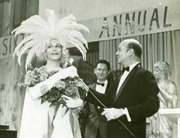
Understanding the Times
In 1950s Houston, it was necessary for gays to be closeted because their careers were at stake. Police regularly drove by known gay bars and wrote down license plate numbers of cars parked in the area. The plates were crosschecked, and employers were notified that one of their employees had recently parked near a known gay establishment. That, in itself, could end a career.
Private homes were the center of gay life during those times. For professionals, this strategy was a necessity, because years of college and career experience could be wiped out by an employer’s knowledge of their sexual orientation. Gay bars did exist in Houston, but for the most part they were small, dark, dingy, and offered little more than a pool table in the way of amusement. Police raided them with regularity, rounding up patrons and bussing them to police headquarters to be booked for indecent conduct. Overt homosexual behavior wasn’t the only thing that police looked for during a raid. Sometimes just being in a known gay establishment was enough to arrest a patron.
Private house parties usually included a mix of gay men and lesbians. Gays didn’t want neighbors to see all men or all women arriving for parties next door. This resulted in gay men and lesbians becoming close, and lifelong friendships were formed.
The people who were invited to attend Diana Awards were generally well educated, socially skilled, and well dressed. To meet the need to appear heterosexual, most paired off into faux boyfriend-girlfriend relationships of gay men and lesbians. A classic irony of this situation is that these faux couples were among the most attractive seen in public places. The very people who forced them to appear straight used them as models to emulate.
For those who took part in the social life of Houston gays, the Diana Awards emerged as one of the most fun parties of the year. With each year, the word spread about the cleverness of the awards, and invitations to the annual party became a social prize. The Diana Awards, though, were still a cohesive group of friends, not an organization. Moncrief and Adams were important to the planning of the annual event and took part in the writing of the roasting awards, but it was becoming clear that the driving force behind the continuing Diana Awards was Charles Hebert.
A social creature by nature, Hebert relished his role as an event planner and coordinator. Long before the Diana Awards, Hebert held annual Halloween and Christmas parties and enjoyed hosting dinner parties. He held season tickets to The University of Texas football games and organized groups of friends to attend with him; former classmates from Dallas, Austin and Baton Rouge were often included in these weekend trips. House parties were often hosted by friends who lived in the city where the game was played.
The people who attended the Diana Awards were part of a larger group of 150 to 200 gay people who made up Houston’s gay social scene. Within the larger group, smaller groups of friends clustered together based on mutual interests and outlooks. Several members of the Dianas group had been classmates at The University of Texas and had known each other from the gay house party circuit in Austin. Diana Awards friends had the reputation of being among the most witty, charming and clever gay people in Houston. Although this group became nicknamed “The A Group,” most members scoffed at the idea. When it was mentioned to Hebert, he would toss away the notion: “The A Group exists only in the minds of the B Group,” he would say.
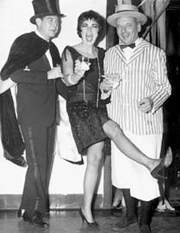
The Houston Gay Social Scene of the ’60s
Police were still hassling gays in the bars of the times. Harry Guyton remembers using a bar urinal one night and suddenly feeling the cold steel of a police revolver against his cheek. Tom Gerrity recalls exiting the Stadium Bar in Rice Village so quickly during a police raid that he dropped a contact lens and didn’t even bother to stop and pick it up.
John Heinzerling remembers his first visit to the Stadium Bar with college friends, to “go laugh at the queers.” The next evening he returned—this time without his friends.
A handful of other gay bars were active in 1960s Houston. Lady Brett’s was located just north of Westheimer Road, where Montrose Boulevard from the south ended at Westheimer. The Thousand and Three, nicknamed “The Numbers,” was at 1003 California Street. The Surf was on Main Street and The European was on Leeland Street.
Sunday dances at the Tomba Club were popular, and lesbians gravitated to the Old Castle Inn. Hazel’s Desert Room on McGowen Street kept a strict mix of male and female patrons. When a red light inside the bar began flashing—a signal that the police were about to enter the club—everyone exchanged dance partners to one of the opposite sex.
Bars closed at midnight during those days. Often, as the music stopped and people got ready to leave, someone would yell out “Come on over to my place!” and an address was shouted out. One night this strategy got out of hand when 98 men showed up at one house. The party was soon reported to the police and all the men were arrested. Many had arrived in convertibles with the tops down. A rainstorm blew through, and when the men were released from jail, they found their vehicle interiors were soaked through.
Private house parties, however, were still the most popular way for gays to socialize. Gerrity’s favorite party was a weekly “Dollar Dinner Night.” Friends took turns hosting a dinner party, and each invited guest paid a dollar. The host was required to provide a meal that cost exactly that much to prepare, requiring creativity and resourcefulness. “All the men came in coat and tie,” Gerrity remembers, “and the lesbians always wore black suits, pearls, and pumps.”
The Nature of the Awards
Those in the Diana Awards social circle continued to provide easy fodder for the annual events—passing out drunk in a public restaurant and falling face first into food, lovers allowing personal differences to become squabbles at inappropriate social moments, or spending too much money for something without obvious merit. The sillier the antics, the louder the howls from the audience as award recipients accepted their prizes with embarrassment.
The language of the awards was peppered with sexuality, using common slang for male and female genitalia. Political correctness was trampled with fandango élan as “dyke,” “faggot,” and “queer” were used with impunity.
To describe the Diana Awards as “suggestive” would be a gross understatement. The language was, depending on one’s sensitivities, risqué, ribald, crass, and lewd. Reveling in double entendres, puns, and other crafty word associations, the writers tried hard not to cross the line from humor to hurt. The awards were meant to be “all in fun.” The awards also reminded guests who attended regularly that “if you play, you pay.” This year may be your year to laugh, but next year may be your turn as target.
Required to appear heterosexual in their daily lives, the assembled group delighted in casting off society’s forced roles once they were behind closed doors. It was common practice for gay men to give each other female names. The names were often alliterative, such as Mona Moncrief and Bessie Bresnahan, or a female spin on a male name—Glenn became Glenda and Ron became Rhonda. Men received the actress awards and women received the actor awards. Perhaps because they constantly lived with a repression of their true selves, in the company of their own kind they laughed away the pressures they lived with.
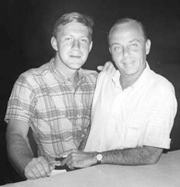
Diana Madness—Growing in Fun and Glamour
By 1960 the Diana Awards had become so popular with Hebert at the helm that he found it difficult to locate a home with a living room large enough to accommodate the guests. Thus Diana 7 was held in a vacant storefront at 3600 Main Street, with room enough to set up rows of chairs, a television set, a bar, and a buffet table. Bresnahan clearly remembers this particular award show, because he was chosen to receive an award. He had recently had surgery in the area of his posterior, and the writers of the awards couldn’t resist the opportunity to tease him about it.
Hebert decided to make the Diana Awards a black tie affair, reflecting the look of the audience at the actual Academy Awards. The parties had always been dressy affairs, but now a new touch of glamour gave the Dianas a look and feel of royal elegance.
Hebert also utilized the technical wizardry of his friend Bill Bridges to make the awards more and more visually amusing. Bridges took charge of sound equipment and lighting. A portable movie screen was set up so that slides could be projected. As each award was read, pictures of the winner were flashed on the screen, visually tying them to the award they were receiving.
Diana 8 in 1961 was held at the Montrose home of custom frame designer Charles Knight at 3401 Graustark Street. Johnna Mueller recalls that the house had “a really large living room.” She also remembers her friend Mildred Reddick setting up a reel-to-reel tape recorder to capture the awards event.
Knight may also have hosted Diana 9 in 1962, or it may have been held on the grounds of David Moncrief’s new home at 4310 Yoakum Boulevard. Moncrief had shut down his floral business around 1960, and with the help of a friend, had begun a catering service.
Moncrief’s big, white, Southern-style home was definitely the venue for Diana 10 in 1963. He still owned the Diana statue, and the plaster goddess was brought out of storage to once again reign over the event that had been named in her honor a decade before. The guest list, now up to about 40, was too large for an event inside his home, so Moncrief set up a large tent in his back yard. Guests were seated at gaily decorated tables, and helped themselves to a buffet dinner.
Bill Massey remembers attending his first Diana Awards party that night on Moncrief’s lawn. “There were television sets everywhere,” he says. “I was totally surprised and amazed.” It was a magical evening for the guests lucky enough to have received an invitation.
It was also in 1963 that Hebert built a row of five townhomes on a tract he had purchased in the 2700 block of Mason Street. The units were designed by the nephew of real estate agent Arthur Talk. Late that same year, Hebert moved into one of the units and leased the other four. Although he and Bresnahan had split up, they continued to be close friends.
The unit Hebert chose for himself, 2700 Mason, was designed by Hebert to fulfill his first love—entertaining. Side-by-side garage spaces for the five units were built at the north side of his unit. Above the garages, he built a large open deck, which he decorated with a few small planters and orange trees. It was here, on his rooftop deck, that Hebert entertained about 50 guests for Diana 11.
A bar was set up on the deck, and he hired Montrose bartending legend Freddie Mae to keep the guests’ glasses full. There was table seating for guests, and the elegant, black-tie crowd ate a buffet dinner in the open air as the twilight sun began to set over Montrose. Television sets were placed conveniently so that guests could watch the Oscar broadcast.
“Give gay men a few extension cords, and they can do anything,” Tom Gerrity laughs, recalling the preparations for the evening.
As usual, Tom Adams and Hebert played co-emcees. By this time, Adams had adopted Louella Goodtimes as his Diana Awards persona. Prior to the awards, Adams as Louella and Hebert would interview pseudo-stars. As they walked among the assembled guests, they would single one out, tagging them with a name that was a hybrid of their own name and the name of a famous movie star. Past award winners were recognized and spotlighted.
As the Diana Awards were presented that spring evening, color slides were once again projected onto a portable screen. Bridges punctuated breaks with current song hits, and Jerry Beasley delighted the guests with a tap dance.
A New Direction for the Awards
Diana 11 in 1964 turned out to be the last show where Adams would play his Louella Goodtimes role. Early in 1965, he fell down the stairs in his garage apartment and died. Hebert’s friend and tenant, Bob Fields, agreed to fill Adams’s role as co-emcee and awards writer, taking on the name Louella Phoebe.
Moncrief had meanwhile moved again, this time to 3007 Ferndale Street. Hebert’s rooftop deck on Mason, in any event, could never have accommodated the ever-expanding guest list. In 1965, Diana 12 was held in Moncrief’s Ferndale back yard. The legendary Diana statue once again reigned over the affair, which was attended by some 60 guests.
Diana Awards always made word plays on the films that were currently nominated for Oscars. And so at Diana 12, Jack Mae Bush received an award for his role in Seven Inches in May. Virginia Caldwell, owner of a pet-grooming salon, won “Best Song” for Coldfinger, and Pat Osborne received “Best Supporting Actor” for My Fair Leslady.
By 1966, the Dianas finally had no other choice except to “go commercial” and look for venues other than private residences in order to accommodate the crowd of guests. Billy Moody, another Hebert tenant, owned the Village Theater in Rice Village, which showed “adult movies” and was known popularly at the time as an “art cinema.” Moody agreed to close the theater to the public for an evening, so that the Diana 13, 14, and 15 awards, from 1966 through 1968, could be held there. It was wonderfully symbolic to hold a party that spoofed movies in a real movie theater.
Up until 1966, Hebert and his close friends paid all the expenses involved in the shows. With the move to the Village Theater, they finally felt the need to charge an admission. The addition of a cover charge made no difference—people receiving an invitation were happy to pay the price.
Television sets were placed along the aisles in the theater, and a bar and beef stroganoff buffet were set up in the lobby. Nan McTeer recalls Jeannie Lantz walking around with an 8mm movie camera with flood lights, taking films of the guests as they arrived for the event and mingled in the theater lobby. When she asked Lantz how she could afford to shoot so much footage, Lantz replied with a smile, “There’s no film in the camera!”
Diana 13 in 1966, like its predecessor shows, brought hoots and laughter from the gathered crowd. The winning song of the year was “The Shadows on Your Thighs” from The Sandra-Piper. Charles Knight, a struggling businessman, took the best supporting actress award for Shop of Fools. Hebert’s current roommate, John “Olive” Ohms, received a special Candace Mossler Award for “achievement in incest” with recognition for his monumental work in “sister tricking” and was honored for his role in Casanova ’69.
In 1967, Diana 14 honored Clinton Quinn as Best Supporting Actress in A Queen for No Reason. Captain Cecil Durham, M.D., just back from Vietnam took the award for Best Foreign Film, Stop the War, I Want a Drink.
It was also at 1967’s Diana 14 that Tom Osborn, a former ice skater with the Sonja Henie troupe, provided the first drag entertainment to be featured at a Diana Awards Show. A friend from his skating days was in town and loaned him an elegant purple show robe. The following year, in 1968, he wowed the audience with another borrowed outfit—this time a Hello Dolly outfit from another touring ice show. Osborn quickly became the Diana’s resident diva, a role he would play for nearly two more decades.
Diana 15 in 1968 found Laville Burnett winning the Best Supporting Actor award for Reflections in a Blackened Eye. Jimmy “Etta” Valentine was given the award for Best Documentary, Dr. Screwlittle. Cassandra McCory was honored for achievement in Makeup for her role in Cassandra, How? Ed Copeland and Bill Hayes accepted in tandem the award for Best Movie, Boney and Clod.
Some of the awards were inside jokes that not everyone understood; this just gave guests the opportunity to tell and hear outrageous stories of the questionable behavior that landed the winners their prizes. With the passage of years, the movie-title word play may not seem so obvious to a younger generation, but in the years that the awards were presented, everyone in the audience quickly understood the hijacked movie titles.
During the years at the Village Theater, a group of men formed the KY Nymphonettes and offered TV commercials for the sex lubricant between awards. Another group, usually their partners, dressed in drag as the Micrin Oral Antiseptic Swallowettes and also performed commercials. Winners of awards now received a copy of the award, a huge bouquet of roses, a bottle of Micrin and a tube of KY. The Diana Awards were becoming a tradition and an institution in Houston’s gay community.
On the Cusp of a New World
Late in 1968, Billy Moody tragically took his own life, leaving the inner circle of the Diana group without a good friend and supporter. It also left them without a venue for 1969.
The Windmill Dinner Theater in the Town & Country area was eventually identified as a venue, and Diana 16 was booked for 1969. Hebert had become friends with Nan McTeer and her partner Linda Mele, a leggy lesbian who worked as a dance instructor for Arthur Murray Dance Studio in River Oaks. He convinced Mele to join Bob Fields and himself as a third emcee and become a part of the award-writing staff.
On April 14, 1969, Mele took to the microphone for the first time at Diana 16. As the emcee at Arthur Murray Medal Balls in the Shamrock Hotel’s Emerald Ballroom, she was comfortable on stage. The audience that filled the Windmill Theater that evening was treated to box lunches and Mele as a new emcee that Hebert named Mr. Alice B. Toklas. Toklas, who owned an imaginary stud bull ranch for “wayward bulls” in Lesbianola, Texas, was warmly received by the guests. That evening, the Dianas entered a new era of their history, expanding their appeal to female members of Houston’s gay community and playing to an audience of around 90 guests.
What no one knew that evening was that, two months later, an event would occur that would rock the nation’s gay community and change it forever. History was on the cusp of the Stonewall Riots on June 28, 1969, in New York City.
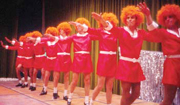
The 1970s The Dianas Make a Move to Gay Bars
As the Diana group of organizers began to plan for Diana 17 in 1970, they found themselves, along with the rest of the nation’s gay community, living in a new world. During the previous summer, the Stonewall Riots had taken place in New York City, and the event had galvanized gays throughout the country.
Gays were news on page one of the New York Times and on the cover of Time. It was clear that, after a history of repression, the gay community was going to fight back against hiding and homophobia. Whether or not Stonewall was the reason, it is interesting that, for the first time since their inception, the Diana Awards would be held in a gay bar. The chosen venue was the Club Romulus at 2151 Richmond Avenue (later to be the site of Club Picasso in the 1990s).
The formula for the awards was basically the same as that developed over the previous years. David Moncrief played the role of Pricene Waterhouse, who handed the sealed awards to a trio of emcee/presenters—Charles Hebert, Bob Fields, and Linda Mele. Hebert greeted the crowd as an alter ego in drag—Angela Lynnesbury, a takeoff on Angela Lansbury who had recently appeared on Broadway as Mame. After his greeting role, Hebert’s Angela disappeared and Hebert changed into a tuxedo for the remainder of the show. Fields wore outrageous hats and stoles in his role as Louella Phoebe, a campy throwback to former movie gossip columnist Louella Parsons, and Mele showed off her leggy, dance-instructor form in cabaret outfits, in her role as Alice B. Toklas the stud bull rancher. (When Mele had originally accepted the role, she was not familiar with Toklas. Finally shown a picture of her, Mele gasped, “Oh no, I don’t look anything like her!”)
As usual, the awards were full of double entendres that mimicked that year’s Oscar nominees. Guests laughed, drank, ate box lunches and then watched the telecast of the Oscars.
Charles Temple, Tom Gerrity’s partner, won the 1970 Best Costume honors for his part in The Virile Do Do. With typical humor, the award described him as a man “who ruined the image of the body shirt.” Betty Lackey won the Best Direction award, for “coming to the big city and not knowing what direction to go—but as it turned out, it was always in the direction of a gay bar.” The award for Best Movie was scooped up by David Peebles for Queen of a Thousand Lays.
Diana 18 and 19, in 1971 and 1972, moved to the Palace Club, high atop 3400 Montrose (later to become Cody’s and now the site of Scott Gertner’s Sky Bar). As guests mingled for pre-awards social hour, a medley of slides of their activities during the past year flashed on a centrally located screen.
At Diana 18 in 1971, Nan McTeer was the hit of the party when she walked in with tiny twinkling Christmas lights in her upswept hair. She and other guests were, as usual, dressed in formal elegance, reminiscent of Academy Awards audiences. Dr. Ronnie Butler won an award for Lovers and Other Hustlers, and McTeer was honored as Best Actor for her role in Five Easy Strippers. The Best Supporting Role awards became the Best Supported awards, where friends were singled out for relationships where the partners’ income levels and ages were strikingly different.
The most biting award of the shows was the Louella Goodtimes Memorial Award, which in 1971 was presented to Nuntius (a forerunner of This Week in Texas) for their part in T-R-A-S-H. Louella Goodtimes was a tribute to the first Diana co-emcee Tom Adams, whose Louella Goodtimes alter ego was described as “a common, trashy, bitchy, evil woman.”
Even movie star Rock Hudson won a Diana award that evening. A friend of Diana supporter Glenn Smith, Hudson usually stayed in Smith’s Courtland Place mansion on visits to the city—and was treated to both Houston hospitality and hot young men from Montrose. In college, Virginia Caldwell had dated Hudson’s publicist and one-time lover, Tom Clark, so she enjoyed a longtime personal friendship with Hudson.
The writers of the awards were cognizant of the different groups of friends who tended to cluster together. Awards were written to try to include as many people as possible, choosing winners from each major group and mentioning names of other people in those groups in the wording of the awards.
Diana 19 in 1972 honored Jimmy Valentine with the Best Movie award, Etta, Queen of Scotch. Nymphonette Peter Forbes received the Best Sets award for helping a friend sponsor a Tupperware party for his Diana friends. With the help of an open bar, and convincing sales pitches, Forbes’s friends went home with armloads of kitchen container sets they would probably never use. It was the most profitable Tupperware party his friend had ever thrown.
For the Palace Club events, Bill Bridges located a current technological wonder that could project television images on a screen. Guests watched the Oscars for the first time on a medium other than a television set. It also eliminated the necessity of setting up multiple television sets so that all guests could see the awards clearly.
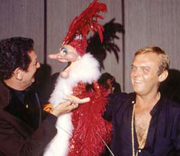
An Important Departure from a Long-Standing Tradition
1973 was the year when the Diana Awards were first held as an event separate from the Academy Awards telecast. Organizers realized that it was difficult for guests to hurry home from work, change to formal wear, and party late on a work night. From now on, they decided, the Dianas would be held on the Saturday night closest to the Oscars.
Moving the awards show to a Saturday, with a later starting hour, meant that organizers no longer had to provide dinner for guests. Removing the Oscar telecast from the event also meant that the popular Dianas Awards show, with its original entertainment, could run longer.
Constantly outgrowing their previous venues, the Dianas moved again, this time to the Hi Kamp Klub, a unique gay bar that featured a raised runway and a stage at one end of the club—perfect for any sort of stage show. The response to the invitations was so overwhelming that the club was packed from wall to wall. This was to be the first and last awards show at this location.
Meanwhile, Hebert and Tim Weaver had begun living together as partners. Weaver was attractive and athletic, with a sweet disposition and an affable personality. When Moncrief fell sick at awards time and needed a replacement, Weaver was quickly pressed into service to fill in as Priscilla Waterhouse. Still new to the whole game, he tried to play his role straight, as the emcees somberly said, “May I have the envelope please, Priscilla?” Weaver recalls with a laugh, “I kept cracking up, and they would glare at me.” But the audience thought he was hilarious.
Among the Diana movie winners that year were The Godmothers, The Heartbreak Builder, and Everything You Wanted to Know about Make-Up, but Were Afraid to Ask.
The ’74 and ’75 Dianas were held at Bayou Landing (later to become The Old Plantation). Sharon Lord remembers that, because tickets were not assigned to specific locations, guests began lining up for the best tables hours before the event.
Weaver, having noted that the awards shows did not have souvenir programs, was appointed to produce one, complete with sponsors. The result was the first printed program at Diana 21—eight pages long, with a sketch of Moncrief”s original Diana statue on the front, a page for autographs, and a little pencil secured on a golden cord.
The original statue, situated on the stage and bedecked with flowers, was now a regular tradition at every Diana Awards show. It provided a sentimental link to that first Diana party in 1954. Because of its size, the statue had to be moved on a dolly, and it took up to four people to get her into position. Bridges, with a build like Mr. Clean, was often convinced to help in the transportation.
Above the stage, “Diana XXI” was spelled out in lights. McTeer remembers creating the letters using plywood and small electric bulbs. The Diana Awards productions were a labor of love, and each year more and more people joined in to make the event more special.
With an obvious age difference between himself and Hebert, Weaver was a prime target for Best Supported Actress and indeed received the honor at Diana 21. Despite the friendly ribbing inherent in the award, Weaver somehow escaped the usual assignation of a female name and was always known simply as “Tim Tim.”
The writers of the 1974 awards lampooned Hollywood once again, with such Diana films as The Men We Were, Summer Trade, Winter Queen and The Peter Chase. Diva Tom “Ava” Osborn and Jerry Beasley delighted the audience with a beautiful dance duet to “Alice Blue Gown.” At the end of the number, Osborn turned around and released a hidden flap, revealing his naked butt. The audience howled.
In 1975, the Diana 22 writers gave a mischievous award to Miss Camp America. Begun in 1969, this group was the only real competition in town for the Dianas, holding an annual drag show that parodied the Miss America pageant. Although friendly rivalry existed between the groups, the Dianas were the original game in town. Thus, Miss Camp America was given an award for Boring Prattle.
Other Diana movies receiving recognition that year were The Grand-Daddy, Part II; The Towering Headdress; and Murder of the American Express. Houston’s leather bar, The Locker, also took a verbal “beating.”
By 1976, Bayou Landing had closed its doors, and organizers chose Dance City in the old Windsor Plaza as the Diana 23 site. Each year the scope of the Diana Awards continued to expand, and a new musical group calling themselves the Dykettes was added to the entertainment list. Mele taught them how to make basic dance moves, and Sandi Bubbert was recruited for her vocal talents. When the group premiered with a rousing rendition of “Stout Hearted Men,” the audience jumped to its feet and gave them a standing ovation.
Peter Forbes remembers being dressed to look like Mae West as the Statue of Liberty that year. “I was in a full-length skintight dress with red, white and blue diagonal stripes and held a torch with a blinking light,” he laughs. “I had to lie on the floor, and they rolled me up into the material.” Dance City was closed down earlier than expected that night, and Forbes had to drive home still wearing the costume. “That dress was so tight, I couldn’t bend my knees, so I had to drive in a totally prone position. And just as I was about to leave the parking lot, someone opened the passenger door of my car and put in a six-foot-tall tube of KY used as a prop on the front seat. I got some strange looks at stop lights that evening.”
The Dianas Formalize an Institution
Although the Dianas charged admission for their shows, the income was still insufficient to pay the expenses of the productions, and private individuals always provided donations to make up the difference. A decision to become a 501(c)(3) charitable organization opened up the possibility that benefactors could use their gifts as tax deductions. It also provided the Dianas with a motivation to make the events financially profitable. In late 1976, the Dianas’ application for charitable status was approved by the IRS, and the Diana Foundation was officially born.
As a charitable foundation, the Dianas sought out worthy recipients for donations from the proceeds they made from their events. They gave four-year scholarships to deserving students at the High School for the Performing Arts, made donations to the Houston Ballet, and helped out numerous other causes.
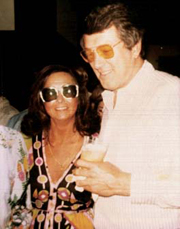
Charles Hebert—Driving Force Behind the Dianas
Hebert was clearly the driving force, and everyone involved was happy to let him coordinate all the tasks that together produced an annual show. But the group had never felt a need for officers and memberships. With the creation of the foundation, there was now a clear list of members and officers. As a requirement of incorporation as a nonprofit, the foundation made a list of charter members. But even today the term “charter member” is often confused for “original participant.”
In the days before the foundation formed, friends involved with the Diana Awards were also involved in many other social activities that had no relation to the Dianas. Over the years, these events sometimes became mistaken for Diana functions. This demonstrates the visibility of the Dianas, but also emphasizes the fact that they were not a socially insular group.
One notable example of a non-Diana event was an annual vodka bicycle trek through Montrose, which often made the society columns. Riders decorated their bikes and had designated stops at various yards for creative vodka drinks. One year, a rider won a Diana Award for falling off her bike, crotch-first into a cactus plant.
Other examples include the bizarre Folleyball Game complete with cheerleaders and Folleyball Queen, overnight outings to Dallas for UT football games, Hebert’s annual Halloween and Christmas parties, and his “Dog Days of Summer Country Dinner.” Hebert had a passion for fun and entertaining and never knew the meaning of a dull moment.
Some of the people close to Hebert were wealthy, some were professionals and some were neither. Money and status could not buy one’s way into Hebert’s social circle. His partner Tim Weaver says that Hebert enjoyed people who were creative, industrious, and mixed well with others. He also felt that social courtesies should be reciprocated.
“He enjoyed attending parties where he could just be a guest,” Weaver says.
Hebert had an acid tongue, but according to many who knew him, he didn’t initiate verbal volleys. But if someone decided to get started with him, they usually found themselves demolished in a matter of seconds. Hebert was seen as “a true gentleman,” but he was definitely not a prude. He could turn the air blue with sexual epithets.
All of these qualities drew a number of people to Hebert. Many of his acquaintances showed up regularly in the Houston society columns, as did events that they sponsored. To the society columnists, the group in which Hebert traveled was referred to as “café society.” Getting your name into the social pages usually was a result of one of two things—being wealthy or being fun. An eternal teenager, Hebert never lost his zest for enjoying life.
Even after the formation of the Diana Foundation, Hebert continued to keep the Dianas as just one facet of his busy life, but as President of the Foundation, he discovered that the Dianas were now becoming a year-round responsibility.
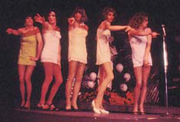
The Diana Awards Expand Exponentially
While plans were underway for Diana 24 in 1977, the group booked a ballroom at the Sheraton Lincoln 717 Polk Street. The Sheraton Lincoln had achieved Houston fame in 1965 when the Beatles stayed there and held a press conference there. Scores of young female fans bought maid outfits and tried to infiltrate their sleeping quarters.
Nothing in the Dianas past came close to the size of these facilities or the opportunities afforded to them. Hebert realized he had a complex event to run and set to work organizing committees to handle all the necessary duties—band, choreography, costumes, decorations, hotel arrangements, invitations and tables, programs, sets, sound and technical, raffle. When it became obvious that a focused effort was needed in a particular area, Hebert created another committee.
Michael Kemper remembers that first year he attended the Diana Awards at the Sheraton. “I felt so proud riding up that escalator to the ballroom. Finally gays had become part of the country club set. We were out in the open and we were with our own.”
The Dianas packed the ballroom with a sell-out performance that year and decided to continue their relationship with the Sheraton through four more shows, Diana 25 in 1978 through Diana 28 in 1981.
The 1977 souvenir program cover for Diana 24 featured King Kong holding the plaster goddess Diana, reminiscent of the old movie poster with Fay Wray in the hand of the giant Kong. The paper chosen for the cover was especially thick and porous. When the covers were printed, the ink soaked in but didn’t dry well. Weaver remembers that he and a crew of volunteers spread the programs out in their living rooms and rounded up oscillating electric fans in an attempt to dry out the ink the night before the show.
Harry Guyton, who volunteered to work with the Sheraton sets, recalls: “For the first time we had a large stage to perform on. We decided to include more lavish musical numbers in the show, and we built the sets in my driveway.”
Sandi Bubbert remembers the astonishment on the faces of the Sheraton staff as the Diana crew arrived to set up for the show. “We wheeled in the portable stage, lights, sound equipment, sets, props and costumes.”
The man responsible for the costumes recounts the efforts it took to actually create the gleam in the designer’s eye. Working from initial sketches, he made a basic pattern, then fitted each of the dancers to an individual outfit. “We planned for similarity with differences,” he says. “For example, all dancers in a can-can routine wore the same style dress, but the petticoats were different colors. The sewing committee gathered enough tulle to run the length of two football fields.”
He found a shoe store in downtown Houston that specialized in large women’s sizes. His dancers would show up at the shop, mention they were with the Dianas, and then be whisked to a private fitting area in the basement, out of the sight of the public.
His sense of realism was keen, and he decided against stuffed bras for breasts. “I put birdseed in the bottom of women’s nylon hose,” he laughs. “That made their breasts move like real breasts would.”
Outfits were hung on racks, one for each dancer, in exactly the order they were to be worn. Volunteers helped each dancer out of one outfit and into the next. The dancers had practiced in advance how to quickly change their makeup.
It was a scramble to prepare the costumes each year, but he had a crew of volunteers with sewing machines in a donated workspace. At the beginning of each evening, as the crew readied for their tasks, he would tap the floor with the metal end of a yard stick until he had full attention. Then he would announce, “Let’s get those machines going!” He earned the nickname of “General.”
By this time, the Micrin bottles and KY tubes had been replaced by small plaster statuettes spray painted a tacky gold color. Although Moncrief’s original plaster Diana, Roman goddess of the hunt, continued as a regular prop on the stage, the statuettes actually looked like Juno, wife of the Roman god Jupiter. In an attempt to find a statuette with generally the same form as an Oscar, mythological purity was left behind.
At the 1977 awards, Hebert broke a statuette in two, giving one half each to partners Gary Evans and David Stone, honoring them for a slugfest they performed before a horrified audience at an annual Folleyball Game, which sent one of them to a local hospital with a broken collarbone.
The Diana Awards dress code continued to be black tie. Forbes remembers that Jim “Fannie” Farmer, the original owner of Mary’s Naturally Bar, showed up with his little dog, which was also in black tie. “That dog sat quietly in a chair and acted so polite the whole evening. He and his owner were later presented with an award for Animal Spouse.”
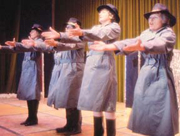
Pets were near and dear to Diana members, and in 1978 the printed program began regularly listing the “Diamond Dogs,” “Cuddly Cats” and “Assorted Dianimals.”
Members tried out for dancing and singing roles and rehearsed endlessly. Song lyrics were altered to be both humorous and brilliantly lewd: “Your Good Fluff’s Gonna Go Butch,”, I’m Gonna Wash That Man Right Out of My Teeth,” “If He Swished Into My Life,” “There is Nothing Like a Queen,” “We Need a Little Amyl Nitrate,” “What I Did for Drag,” “Get Us to the Baths on Time,” “Deep in the Crotch of Texas” and “There’s No People Like Gay People.”
But awards for bad behavior had always been the Diana signature feature, and the award writers continued to identify and reward the guilty. Bob King joined the award-writing efforts in the late 1970s and continued for nearly two decades. He remembers those years: “Some awards took four to six hours to write those 200 or so words. Hard to believe, but we wrote 14 of them every year.Charles and I had a rule that if the award did not make us laugh then scrap it.The next day we scrapped many.We tried to go as far as we could and not go too far and hurt someone. Being non-professionals, we managed to do that most of the time. I would have never intentionally hurt someone. Delivery made a difference.I worked with presenters over and over.”
Popular entertainer Waylon Flowers was flown in for the 1978 and 1979 shows to entertain with his puppets Madame and Jiffy. In 1978, Jiffy presented the Louella Goodtimes Memorial Award to singer and anti-gay crusader Anita Bryant (who did not attend to accept): “This star’s career is on the rocks, her marriage is on the rocks, she’s on the rocks, and what she needs is to get her rocks. She is dedicated to saving the children from us, and we are dedicated to saving the children from her. This woman has made her living selling fruits and is now trying to make her living selling fruits down the river.” The award was met with loud, aggressive approval.
The Sheraton shows honored Diana films Voyage of the Drunks; Marathon Mammaries; Nutworks; The Other Side of the Glory Hole; Hijack 77; A Strange Encounter of the Worst Kind; and The Boys from Baytown.
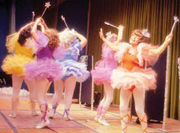
Seemingly, no one and nothing was exempt from the Diana Awards arrows—entertainer/stripper Ricci Cortez, the Midnite Sun, The Depository II, the Campisi brothers Joe and Frank, Stage Struck Productions, and the Houston Gay Political Caucus.
Having reached a silver anniversary, the Dianas had clearly become a community institution. Sold-out performances were a given. Demand for tickets always exceeded the supply available. Facing the dawn of the 1980s, they were unstoppable.
_______________________
Next month, OutSmart continues its exclusive history of the Dianas with the second part of this two-part series.
Coming up: the Dianas hit the big time at the Tower Theater; exceed all expectations; begin to feel the impact of AIDS; endure a loss that cuts deep into the core of their collective soul; move to the Wortham Center; deal with internal upheaval that threatens their existence; learn to re-invent the organization; and ultimately prove themselves to be survivors.
Also see:
More on the Dianas (including Programs, links, contact info, etc.)
_______________________
For an extended experience of the history of the Diana Foundation, please go to Facebook (www.facebook.com) and enter “The Diana Foundation” in the search box. Then click on the link that is displayed.
If you are not a Facebook member, you will need to sign up, but the process is simple, and you can give minimal information to do so. Once on The Diana Foundation page, click on Become a Fan.
The Facebook page has a special look at what the guests at Diana 1 saw on television the night the Dianas were born on March 25, 1954; hundreds of photos of past Diana Awards shows; on-line video clips from Diana Awards shows; copies of Diana Awards; covers of all past programs; and personal photos shared by current or former Diana members.
The page also provides the ability to leave your own comments, take part in discussions, and share your own Diana photographs and/or videos.
_______________________________
The author of this article wishes to thank the following individuals for their role in the preparation of this article, without whose help the story could not have been told: Christine Doby, for countless hours of interview transcription, copy editing, and research assistance; John Heinzerling and Harry Guyton of the Diana Foundation; Jo Collier, Joel Draut and Charles Stephenson at the Houston Metropolitan Research Center at the Houston Public Library; Art and Lynn Graeter at House of Glass; Larry Criscione and the volunteers at the Charles Botts Archive; and numerous members, past and present of the Diana Foundation.


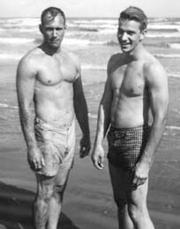









Comments